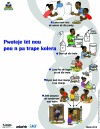Lessons learned during public health response to cholera epidemic in Haiti and the Dominican Republic
- PMID: 22099111
- PMCID: PMC3310587
- DOI: 10.3201/eid1711.110827
Lessons learned during public health response to cholera epidemic in Haiti and the Dominican Republic
Erratum in
- Emerg Infect Dis. 2011 Dec;17(12):2399
Abstract
After epidemic cholera emerged in Haiti in October 2010, the disease spread rapidly in a country devastated by an earthquake earlier that year, in a population with a high proportion of infant deaths, poor nutrition, and frequent infectious diseases such as HIV infection, tuberculosis, and malaria. Many nations, multinational agencies, and nongovernmental organizations rapidly mobilized to assist Haiti. The US government provided emergency response through the Office of Foreign Disaster Assistance of the US Agency for International Development and the Centers for Disease Control and Prevention. This report summarizes the participation by the Centers and its partners. The efforts needed to reduce the spread of the epidemic and prevent deaths highlight the need for safe drinking water and basic medical care in such difficult circumstances and the need for rebuilding water, sanitation, and public health systems to prevent future epidemics.
Figures



References
-
- Barua D. History of cholera. In: Barua D, Greenough W III, editors. Cholera. New York: Plenum; 1992. p. 1–36.
-
- Pan American Health Organization. Cholera situation in the Americas [cited 2011 May 18]. http://www.paho.org/English/sha/epibul_95-98/be971cho.htm
-
- Gaffga NH, Tauxe RV, Mintz ED. Cholera: a new homeland in Africa? Am J Trop Med Hyg. 2007;77:705–13. - PubMed
MeSH terms
Substances
LinkOut - more resources
Full Text Sources
Medical
